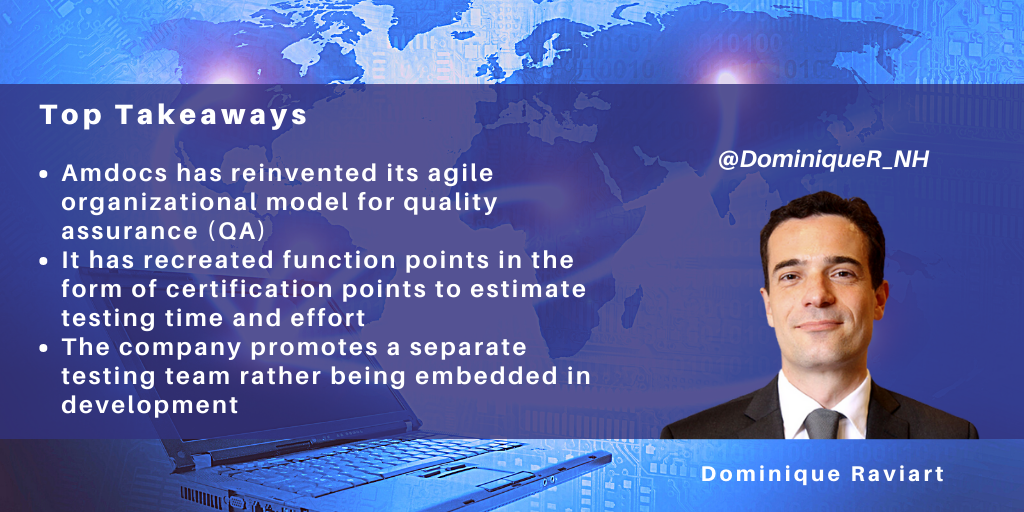Search posts by keywords:
Filter posts by author:
Related NEAT Reports
Other blog posts
posted on May 04, 2022 by Dominique Raviart

The world of quality assurance (QA) is continually evolving, alternating between cycles of centralization and decentralization. QA became part of testing CoEs in the 2000s, driving process standardization, test coverage and automation. More recently, in its latest organizational model, it has become part of the agile development structure and is spread across agile projects. Quality engineers work alongside developers in agile teams of three to seven specialists, focusing on test automation and targeting the holy grail of QA: in-sprint automation.
We recently spoke with Amdocs’ Quality Engineering (AQE) organization about how the unit is embracing this trend. While Amdocs is well known for its software products for communication service providers (CSPs), the company now primarily operates under an IT service model, with AQE enjoying rapid growth. For example, AQE recently won a significant standalone testing contract from a tier-one CSP. The scope is large and involves ~200 applications, including new builds and applications in maintenance. The company will scale up to several hundred quality engineers at peak time. AQE is approaching the project by implementing a new organizational model based on agile and continuous testing principles.
Amdocs adapts function points for agile QA
For this project, AQE reinvented the function point estimation model for QA that is common in software development. The unit uses certification points to estimate the time and effort required to complete a QA activity. Beyond functional testing, the pricing model also covers non-functional and other areas such as test environment provisioning.
The function point-like approach is not new (a few vendors already took that route back in the mid-2010s) and has both advantages and disadvantages. On the positive, it has helped CSPs and vendors move past a T&M model to mitigate risks in fixed-price projects. Yet function points had drawbacks, e.g., counting function points took time and were manual, with experts sometimes diverging on their function point estimates. AQE aims to resolve this challenge by automating most counting of new functional features using agile program increment (PI). Also, AQE provides its estimate two months before the PI gets to development, giving clients visibility of upcoming costs to refine the scope of PIs.
Redefining agile QA teams
In the organization space, AQE is promoting a different approach, incorporating both centralized and decentralized aspects. The idea is that rather than embedding QA into an agile development team, AQE relies on a separate team of functional and technical experts, independent from the agile development unit.
For example, for the abovementioned project, AQE created standalone atomic QA teams to provide a broad spectrum of quality engineering activities, from functional to non-functional and quality engineering. In addition, AQE employed its automation IP and accelerator portfolio to increase the level of test automation.
By covering processes and analysis, AQE’s organizational approach goes beyond just setting up standalone QA expert teams. The organization highlighted that, as part of this project, it discovered that the client had focused most of its QA activities on integration testing.
AQE took a broader pespective on the project, helping the client shift from integration testing to E2E testing. In addition, AQE introduced unit testing among developers, thereby detecting defects earlier in the lifecycle.
AQE’s targets for the client include improving velocity by 80%, achieving cost savings of up to 50%, moving from quarterly to monthly releases, increasing resiliency, and improving customer satisfaction rankings. They demonstrate that QA is having an increasing and quantifiable impact on business outcomes.
